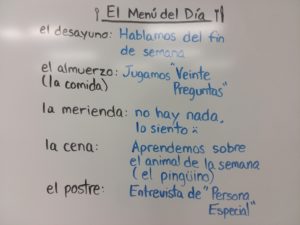
Why It’s Important to Write Down Your Plan for the Day
Do you find yourself planning solid activities that deliver loads of comprehensible (and comprehended) input but get caught in the moment and forget what you’re doing next? I’m going to share with you how I help myself and help my students keep the class running smoothly with the unique way that I write down my plan of the day.
My students always confuse the names of different meals in Spanish. I got this idea from a colleague my first year of teaching and have been implementing it ever since. Start with breakfast and work your way to after-dinner dessert. It’s OK if you don’t have an activity for each “meal.” You’ll find yourself pointing to the names of the meals on a regular basis during activities like PQA and Weekend Chat. For example:
- “Brynn, what did you eat for breakfast this morning?”
- “Class, it’s Tuesday. What’s for lunch in the cafeteria today? That’s right! It’s chicken tender Tuesday!”
- “Austin, I remember you telling me that The Cheesecake Factory is your favorite restaurant. What do you normally eat for dessert when you go there?”
- “Who has a snack with them today? What is it? Is it healthy or not?”
- “Maddie, when does your family eat dinner?”
- “Lexi, when is your lunch period?”
1. It keeps you on track and helps you manage your time.
Some teachers are better at “winging it” than others. For example, I can’t think that fast on my feet when I’m going completely untargeted when storyasking. I expend too much conscious mental bandwidth trying to stay in bounds (not adding too much new vocabulary) and more than anything, remembering the details that my students voted on.
Even during semesters when I only had one prep and taught the same 90-minute block three times a day, I liked being able to glance over at my whiteboard to remind myself of where the lesson was going next. I’m that guy who can spend hours preparing a fun, high-speed, low-drag activity and then forget to do it until we have 10 minutes left in class! Now the activity has to wait for tomorrow and some of the novelty inevitably wears off.
2. Transitions between activities are more efficient.
Every teacher prep program stresses that poorly executed transitions can eat your classroom management for breakfast, lunch, and dinner. Having my plan written on the board is especially helpful on days when my activities are a bit eclectic and there’s no clear way to transition from one activity to the next. For example, if we are starting class with work in the class novel followed by Jeopardy!, I might prime the Jeopardy! game by reminding the class that there will be a category in the game specific to the character or issue that we’re discussing in the novel and tell them that the winning team can raid my treasure chest of candy. Now it’s already in the students’ heads what’s coming next so they’ll waste less time getting settled into their teams since they’re already in the competition mindset.
Novice and veterans teachers alike recognize that their transitions from one activity to the next go smoother when they take the time to intentionally plan them. I sometimes draw little symbols or use different colors of markers in between the activities on my daily agenda to guide my transitions. For example, if our final activity for the day is Two Truths and a Lie, I might draw a tiny stick figure stingray somewhere off to the side to remind myself to use one of my two “truths” that has to do with a stingray in order to introduce the activity. Without my drawing, I still could have transitioned efficiently to the activity, but the class would have missed out on an entertaining story in the target language that serves as an intriguing hook.
We don’t usually think about starting class as a transition, but it really is when you consider how much emotional and physical upshifting and downshifting students are doing as they arrive to your class. If you still don’t think it’s a transition, think about how much time you waste when you do it inefficiently. After briefly daily announcements in the target language, I start class with individual FVR (Free Voluntary Reading) four days a week. Most students see this written on the board next to the word “breakfast” as they’re walking in and grab their readers from my spinning rack that is right inside the entrance to my classroom. This helps get everyone settled down at the start of class. I estimate that this practice alone saves over an hour over the course of a semester.
3. Your students function better and are more at ease when they know what’s on the agenda.
It’s easy to forget what it feels like to be a student, especially in a class conducted in a language that is still very new to you. This is particularly problematic in our discipline because even low-grade anxiety about what is going to happen in class that day can really spike our students’ affective filters and cause them to shut down. Even a first-year language teacher has had thousands and thousands of hours of input, while most of our students have between zero and several hundred if they stick with the program to the end.
If it’s Monday and you’re going to lead off with Weekend Chat, write it down in the “breakfast” spot so your students have a second to think about something interesting they could talk about or answer questions about from their weekend. Just like with our L1, there is a difference between needing time to think of something to say and needing time to think how to say it. The former is fine, however we want to keep the latter process in our students’ subconscious minds since we are teaching for proficiency (unrehearsed, extemporaneous production of speech on a somewhat familiar topic performed in a culturally competent manner).
Even your students who don’t outwardly appear excited about being there still want to know what to expect on any given day in your class. I’ve always been surprised by how many questions (often in L2 at that!) that I’ll get from students who are curious about one of the activities in the couple of minutes that we have before I start class. This happens most often when they recognize the Animal of the Week and have a funny story to tell me about it.
4. It makes it easy for administrators to get a general idea of what you’re doing in class that day.
Do I think that you need to have your learning objectives or the state standards written down on your board if the children are going to have any chance of learning that day? Of course not. Neither do your administrators. They were teachers too not that long ago, too. Assume positive intent in others.
Put yourself in your administrator’s shoes for a second. How would you ensure that the district and building initiatives that you are responsible for carrying out are being implemented in the classroom if you rarely stepped foot into a class apart from when you are required to by the state for official observations?
Administrators are responsible for ensuring that classroom environments are conducive to learning and that teachers are employing pedagogically sound practices. A large part of this is verifying that teachers are being professionals and coming to class prepared. Regardless of how targeted your instruction is, you should have something written down both in your planner and somewhere in the classroom that is visible to students.
If we’re teaching in the target language 90% of the time as we should be, then we will want to make it a point to walk over to our written plan of the day and explain (in L1 or slow, comprehensible L2 with gestures) so that they know what they’re seeing. You’ll get bonus points for doing it in L2 and your students will love watching their principal have that “a-ha” moment.
5. It helps students who arrive late and leave early.
In an ideal world, students would never be absent and they would be in our room from bell to bell. The reality is that braces need tightened, college campuses need visited, and driver license exams need taken.
Having your plan written on the board in the same space every day puts the responsibility on the student on days when he or she is not present the entire class. Students who need to sign out early can know in advance what they need to do independently at home. They can ask me for a copy of handouts or readings at the beginning of class since they already know in a general sense what they will be missing and will avoid interrupting my lesson when they arrive or get up to leave.
